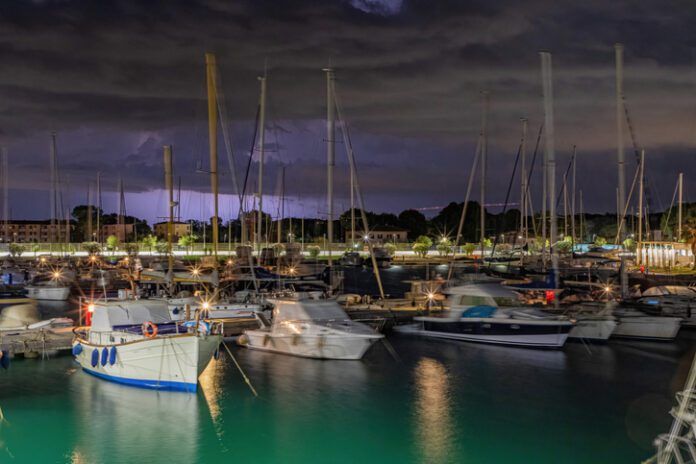Most boat owners have only the vaguest idea of what is involved in protecting their boats from lightning damage. Many believe that their boats are already protected by the boat’s grounding system. Most are wrong.
Just because your boat may be bonded with heavy copper conductors connecting the masses of metal in the boat doesn’t mean that it is protected against lightning. A bonding system may be a part of a lightning protection system, but bonding itself offers no protection to the boat unless a good, direct path to ground is part of the system.
While neither aluminum nor stainless steel is an outstanding electrical conductor, the large cross-sectional area of both the mast and the rigging provide adequate conductivity for lightning protection. The trick, however, is getting the electricity from the mast and rigging to the water.
The straighter the path is from conductor (mast and rigging) to ground, the less likely are potentially dangerous side flashes. Put simply, side flashes are miniature lightning bolts which leap from the surface of the conductor to adjacent metal masses due to the difference in electrical potential between the charged conductor and the near by mass of metal. Ideally, therefore, the path from the bottom of the mast and rigging to ground would be absolutely vertical. In practice, this is rarely achieved.
If the boat has an external metal keel, the mast and standing rigging is frequently grounded to a keelbolt. There are pitfalls to this method. First, the connection between the bottom of the mast and rigging to the keelbolt must be highly conductive. ABYC (American Boat and Yacht Council) standard TE-4 for lightning protection systems require that these secondary conductors have a conductivity at least equal to that of AWG #6 copper-strand cable. There is no drawback to using an even larger conductor.
Connecting the short conductor to the mast and keelbolt presents some problems. A crimp eye can be used on the end that is to be attached to the mast, but you may have to fabricate a larger eye for attachment to the keelbolt. This can be made from sheet copper. Soldering the connections is not recommended, since the heat generated in a lightning strike could melt the solder.
Then you have to face up to a basic problem. Your mast is aluminum, yet you’re connecting it to ground with a copper cable. Everyone knows that aluminum and copper are not galvanically compatible, so what’s the solution? While it will not eliminate corrosion, a stainless steel washer placed between the copper cable’s end fitting and the aluminum mast will at least retard it. But this connection is going to require yearly examination to make sure that a hole isn’t being eaten through the mast. In addition, of course, the process of corrosion creates wonderful aluminum oxide byproducts, which have very low conductivity. The aluminum oxide may reduce conductivity to the point where your theoretical attachment to ground is in fact non-existent. Once again, disassembling the connection and cleaning it yearly are essential to maintain conductivity. Constant attention to all the conductor connections is essential in any grounding system, whether it’s for lightning protection or grounding of the electrical system.
For more information on how to best protect your boat from lightning strikes, purchase Nigel Calder’s Boatowner’s Mechanical & Electrical Manual from Practical Sailor.










































